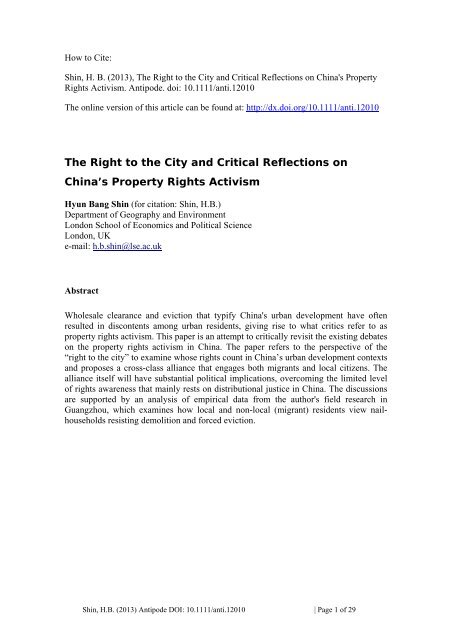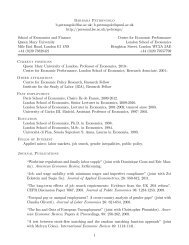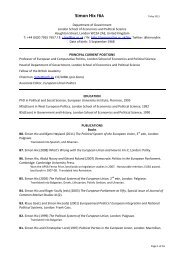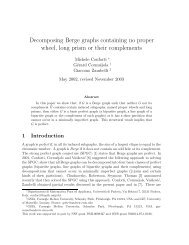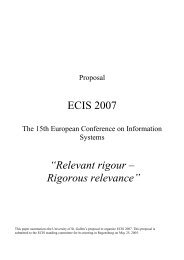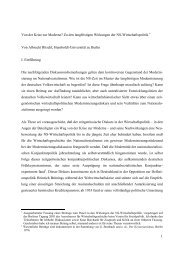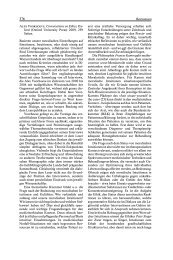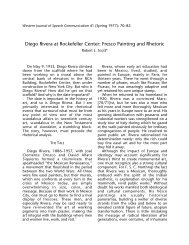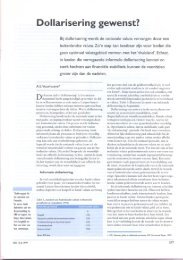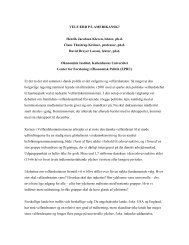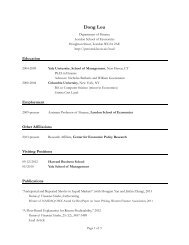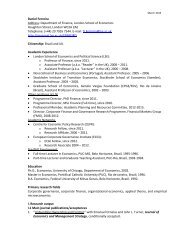View PDF - LSE - London School of Economics and Political Science
View PDF - LSE - London School of Economics and Political Science
View PDF - LSE - London School of Economics and Political Science
Create successful ePaper yourself
Turn your PDF publications into a flip-book with our unique Google optimized e-Paper software.
How to Cite:<br />
Shin, H. B. (2013), The Right to the City <strong>and</strong> Critical Reflections on China's Property<br />
Rights Activism. Antipode. doi: 10.1111/anti.12010<br />
The online version <strong>of</strong> this article can be found at: http://dx.doi.org/10.1111/anti.12010<br />
The Right to the City <strong>and</strong> Critical Reflections on<br />
China’s Property Rights Activism<br />
Hyun Bang Shin (for citation: Shin, H.B.)<br />
Department <strong>of</strong> Geography <strong>and</strong> Environment<br />
<strong>London</strong> <strong>School</strong> <strong>of</strong> <strong>Economics</strong> <strong>and</strong> <strong>Political</strong> <strong>Science</strong><br />
<strong>London</strong>, UK<br />
e-mail: h.b.shin@lse.ac.uk<br />
Abstract<br />
Wholesale clearance <strong>and</strong> eviction that typify China's urban development have <strong>of</strong>ten<br />
resulted in discontents among urban residents, giving rise to what critics refer to as<br />
property rights activism. This paper is an attempt to critically revisit the existing debates<br />
on the property rights activism in China. The paper refers to the perspective <strong>of</strong> the<br />
“right to the city” to examine whose rights count in China’s urban development contexts<br />
<strong>and</strong> proposes a cross-class alliance that engages both migrants <strong>and</strong> local citizens. The<br />
alliance itself will have substantial political implications, overcoming the limited level<br />
<strong>of</strong> rights awareness that mainly rests on distributional justice in China. The discussions<br />
are supported by an analysis <strong>of</strong> empirical data from the author's field research in<br />
Guangzhou, which examines how local <strong>and</strong> non-local (migrant) residents view nailhouseholds<br />
resisting demolition <strong>and</strong> forced eviction.<br />
Shin, H.B. (2013) Antipode DOI: 10.1111/anti.12010 | Page 1 <strong>of</strong> 29
Introduction<br />
Because <strong>of</strong> their heavy focus on demolition <strong>and</strong> reconstruction, China’s urban (re-<br />
)development projects <strong>of</strong>ten incur a large scale <strong>of</strong> displacement <strong>of</strong> residents whose<br />
discontents would, in turn, emerge <strong>and</strong> escalate out <strong>of</strong> the frustration over the violation<br />
<strong>of</strong> their perceived legitimate rights to their l<strong>and</strong> <strong>and</strong> housing. The growing degree <strong>of</strong><br />
dissatisfaction is reflected in the recent popularisation <strong>of</strong> a Chinese neologism known as<br />
“ding-zi-hu” in Chinese, which is literally translated as “nail-houses” or “nailhouseholds”.<br />
As the expression suggests, nail-householders stubbornly refuse to vacate<br />
their houses, hindering the progress <strong>of</strong> urban development projects like nails sticking<br />
out <strong>and</strong> hard to be removed (see, for example, Watts 2007).<br />
To an extent, the term alludes to the rise <strong>of</strong> a contemporary Chinese version <strong>of</strong><br />
practising “right to stay put” by local residents, persistently resisting unwilling eviction<br />
<strong>and</strong> demolition (Hartman 2010 [1984]; Newman <strong>and</strong> Wyly 2006). Their struggles<br />
sometimes led to fatal incidents in which protesters took on drastic measures <strong>of</strong> risking<br />
their own lives (China Daily 2010). Nail-houses provide a vivid example <strong>of</strong> urbanites'<br />
outcry in China, reflecting what critics refer to as “property rights activism” (Lee 2008).<br />
Similarly, You-tien Hsing refers to nail-houses as “the ultimate form <strong>of</strong> localized social<br />
activism” that attempts to protect local residents’ properties from forceful expropriation<br />
(Hsing 2010:207).<br />
Against this background, this paper critically examines if property rights activism can<br />
be an effective emancipatory strategy for urban inhabitants whose livelihoods are<br />
increasingly threatened by accumulation needs. The paper resorts to the empirical<br />
findings that examine how nail-houses are viewed by urban inhabitants, <strong>and</strong> if there is a<br />
potential for these urban inhabitants to form an alliance irrespective <strong>of</strong> their socioeconomic<br />
characteristics. The set <strong>of</strong> empirical data for this paper was collected in<br />
Guangzhou between 2009 <strong>and</strong> 2011 (more details <strong>of</strong> the data collection to be found in<br />
the fourth section). In terms <strong>of</strong> the analytical perspective, I refer to the “right to the city”<br />
(Lefebvre 2003; Marcuse 2009) <strong>and</strong> contextualise whose rights count in China. In doing<br />
so, this paper makes several contributions to the literature as follows.<br />
First, the paper extends the debates on the right to the city to China’s urban contexts,<br />
<strong>and</strong> attempts to produce what Laurence Ma (2007) calls “local epistemologies”. This<br />
requires critical knowledge to be constructed about the experience <strong>of</strong> urban inhabitants,<br />
Shin, H.B. (2013) Antipode DOI: 10.1111/anti.12010 | Page 2 <strong>of</strong> 29
embedded in the existing regulatory practices <strong>and</strong> institutional settings. In particular,<br />
this paper argues that China’s rights awareness currently rests largely on the rights to<br />
subsistence or economic security, without going further to claim rights against the state.<br />
Second, this paper is an attempt to respond to the urgent call to go “beyond empiricism”<br />
in studies on urban China, <strong>and</strong> to address “the critically important issues <strong>of</strong> social <strong>and</strong><br />
environmental justice” (Ma 2007:556). While expressing “a strong sense <strong>of</strong> empathy for<br />
the feelings <strong>and</strong> experiences <strong>of</strong> the disadvantaged individuals under study” (Ma<br />
2007:563), it is also important to build grounded knowledge about how nail-houses are<br />
received by local as well as non-local (migrant) residents. Third, this study pays<br />
attention to the implications <strong>of</strong> fitting migrants into the overall struggles against topdown<br />
impositions <strong>of</strong> urban development projects that affect their homes, albeit rented.<br />
The existing debates on urbanites’ struggles against urban transformation tend to focus<br />
implicitly on permanent residents, that is registered local households who enjoy<br />
comparatively more privileged access to urban <strong>and</strong> social services based on “local<br />
citizenship” (Smart <strong>and</strong> Smart 2001). This paper, however, critically examines the<br />
limits <strong>of</strong> such prioritisation <strong>of</strong> permanent residents, <strong>and</strong> advocates the urgency <strong>of</strong><br />
forming a broader alliance <strong>of</strong> urban inhabitants, including migrants.<br />
The rest <strong>of</strong> this paper consists <strong>of</strong> five sections. The first reviews literature on the right to<br />
the city <strong>and</strong> draws implications in relation to China’s urban contexts. The second<br />
section explains how nail-housesholds have emerged in China. The third examines the<br />
empirical data that illustrate how nail-houses are viewed by local residents. By revisiting<br />
the existing literature <strong>and</strong> the empirical findings, the fourth section elaborates<br />
on the limits <strong>of</strong> property rights activism <strong>and</strong> scrutinises the awareness <strong>of</strong> rights in<br />
China. The final section concludes by elucidating the implication <strong>of</strong> advocating a crossclass<br />
alliance between local citizens <strong>and</strong> migrants.<br />
Contextualising the right to the city: Whose rights count<br />
Recently, a number <strong>of</strong> academics, activists <strong>and</strong> ordinary citizens have been drawn<br />
towards the perspective <strong>of</strong> the right to the city for contemplating the prospect <strong>of</strong> making<br />
progressive urban interventions. The perspective has also been increasingly borrowed<br />
by international organisations, such as the UN Habitat, for the acquisition <strong>of</strong><br />
redistributive justice. The Lefebvrian notion <strong>of</strong> the right to the city, however, goes<br />
beyond this, <strong>and</strong> actively seeks political programmes to intervene <strong>and</strong> take control <strong>of</strong><br />
the process <strong>of</strong> the production <strong>of</strong> urban space (Lefebvre 2003):<br />
Shin, H.B. (2013) Antipode DOI: 10.1111/anti.12010 | Page 3 <strong>of</strong> 29
the right to the city is like a cry <strong>and</strong> a dem<strong>and</strong>...The right to the city cannot be conceived<br />
<strong>of</strong> as a simple visiting right or as a return to traditional cities. It can only be formulated as<br />
a transformed <strong>and</strong> renewed right to urban life (Lefebvre 1996: 158; original emphasis)<br />
For Henri Lefebvre, the proliferation <strong>of</strong> capitalist accumulation has resulted in an<br />
increasing level <strong>of</strong> disenfranchisement <strong>of</strong> urban inhabitants. To reverse the process,<br />
Lefebvre calls for the right to the city that involves “an urban spatial approach to<br />
political struggles with the participation <strong>of</strong> all those who inhabit the city without<br />
discrimination” (Dikeç 2001:1790). According to Mark Purcell, two essential rights are<br />
at the heart <strong>of</strong> Lefebvre’s proposition: the right to participation <strong>and</strong> appropriation<br />
(Purcell 2002). The right to participation calls for urban inhabitants to take a key role in<br />
deciding the production <strong>of</strong> urban space. On the other h<strong>and</strong>, the right to appropriation<br />
involves confrontations with the process <strong>of</strong> capital accumulation that is centred around<br />
the valorisation <strong>of</strong> urban space (Purcell 2002:101-103).<br />
David Harvey pays more attention to the fundamental political economic contradictions<br />
in the capitalist accumulation processes. He argues that “Patterns in the circulation <strong>of</strong><br />
surplus value are changing but they have not altered the fact that cities...are founded on<br />
the exploitation <strong>of</strong> the many by the few” (Harvey 1976:314). Hence, Harvey focuses on<br />
the process <strong>of</strong> accumulation by dispossession, which does not simply occur at the<br />
primitive stage <strong>of</strong> capitalist development, but at various stages <strong>of</strong> capitalism to<br />
supplement existing cycles <strong>of</strong> accumulation (Harvey 2008:34). With his interpretation<br />
<strong>of</strong> the contemporary urbanisation as a spatial fix to the crisis in the accumulation <strong>of</strong><br />
capital, the right to the city is not merely about exp<strong>and</strong>ing inhabitants’ access to the city<br />
in quantitative terms but about being part <strong>of</strong> the process to make cities qualitatively<br />
different (Harvey 2003). The struggle to acquire the right to the city therefore inevitably<br />
centres on struggles against the capitalist accumulation.<br />
The right to the city is far more than the individual liberty to access urban resources: it is a<br />
right to change ourselves by changing the city. It is, moreover, a common rather than an<br />
individual right since this transformation inevitably depends upon the exercise <strong>of</strong> a<br />
collective power to reshape the processes <strong>of</strong> urbanization (Harvey 2008:23)<br />
In this regard, the dem<strong>and</strong> for the right to the city should be about gaining “greater<br />
democratic control over the production <strong>and</strong> utilization <strong>of</strong> the surplus” (Harvey 2008:37).<br />
Lefebvre’s right to the city is also based on autogestion, which refers to the “democratic<br />
participation, workers’ self-management, <strong>and</strong> control <strong>of</strong> ordinary peoples’ destinies”<br />
<strong>and</strong> which “must be perpetually negotiated <strong>and</strong> enacted, relentlessly practiced <strong>and</strong><br />
Shin, H.B. (2013) Antipode DOI: 10.1111/anti.12010 | Page 4 <strong>of</strong> 29
earned” (Merrifield 2006:140). The key is to “bring people together to oppose the<br />
‘omnipotence’ <strong>of</strong> the state <strong>and</strong> multinational capital” (ibid.).<br />
One <strong>of</strong> the challenging questions is whose rights count, which is at the core <strong>of</strong> Peter<br />
Marcuse’s enquiry (Marcuse 2009). Marcuse’s reinterpretation <strong>of</strong> Lefebvre underst<strong>and</strong>s<br />
the right to the city as involving “an exigent dem<strong>and</strong> by those deprived <strong>of</strong> basic material<br />
<strong>and</strong> existing legal rights, <strong>and</strong> an aspiration for the future by those discontented with life<br />
as they see it around them, perceived as limiting their own potentials for growth <strong>and</strong><br />
creativity” (2009:190). Here, Marcuse makes a distinction using economic <strong>and</strong> cultural<br />
terms to define whose right we need to protect <strong>and</strong> exp<strong>and</strong>. Economically, the deprived<br />
are classified to include the excluded (who are part <strong>of</strong> the capitalist system but without<br />
the same level <strong>of</strong> social protections gained by the working class) <strong>and</strong> the working class<br />
itself. In cultural terms, Marcuse puts emphasis on exp<strong>and</strong>ing the right <strong>of</strong> the directly<br />
oppressed (in race, ethnicity <strong>and</strong> so on) <strong>and</strong> the alienated (<strong>of</strong> any factions <strong>of</strong> economic<br />
class <strong>and</strong> social groups that resist the ruling system) (Marcuse 2009). Other than these,<br />
those ruling groups who hold material interests (eg business people, gentry, capitalists,<br />
establishment intelligentsia <strong>and</strong> political elites) are thought to have already acquired the<br />
right to the city in their own terms. This point has also been echoed by David Harvey<br />
who also laments that “Increasingly, we see the right to the city falling into the h<strong>and</strong>s <strong>of</strong><br />
private or quasi-private interests” (Harvey 2008:38).<br />
The perspective <strong>of</strong> the right to the city has been around for some time, but it is yet to be<br />
translated into fully established urban practices. It is imperative to seek strategies<br />
attuned to various urban contexts, as the forms <strong>and</strong> shapes <strong>of</strong> the struggle for the right to<br />
the city should be imagined by taking into account the local configuration <strong>of</strong><br />
institutional regulatory structure as well as the contradictions within specific political<br />
economic systems. As Dikeç states, “approaches to, <strong>and</strong> principles <strong>of</strong>, justice are time<br />
<strong>and</strong> space specific” (2001: 1788). Therefore, any discussions about identifying the<br />
emancipatory right to the city <strong>and</strong> organising its corresponding movement should<br />
address this spatio-temporal specificity. With the need to involve marginalised urban<br />
populations <strong>and</strong> form a solidarity that encompasses conventional class-based labour<br />
movements, the right to the city movement becomes a struggle that strives to secure<br />
access not only to urban space but also to “political space” (Dikeç 2001:1790), while<br />
being sensitive to specific urban socio-political, economic <strong>and</strong> institutional contexts.<br />
Shin, H.B. (2013) Antipode DOI: 10.1111/anti.12010 | Page 5 <strong>of</strong> 29
What are the implications <strong>of</strong> such discourses regarding whose rights count in China’s<br />
urban contexts? At present, the fate <strong>of</strong> urban inhabitants facing (re-)development<br />
projects is heavily determined by existing sets <strong>of</strong> regulations <strong>and</strong> institutional<br />
arrangements. The access to various urban <strong>and</strong> social services in China, including<br />
compensation schemes upon displacement, is conferred upon a particular notion <strong>of</strong><br />
“citizenship” that has been redefined in the process <strong>of</strong> the country’s economic<br />
transition: that is to say, citizenship in China is rendered as a right to socio-economic<br />
benefits rather than “political claims against the State” (Keane 2001).<br />
One <strong>of</strong> the persistent institutions that shape the geography <strong>of</strong> social rights is the<br />
household registration system called hukou in Chinese, which has been in place since its<br />
formal implementation in late 1950s. It functions as a tenacious measure to dissociate<br />
migrants with no permanent local hukou from accessing social services in their<br />
destination cities (Solinger 1999). Li Zhang also finds that migrants are “still <strong>of</strong>ficially<br />
classified as temporary residents in the city <strong>and</strong> treated as noncitizens” (2002:317-318),<br />
facing “prejudice <strong>and</strong> unequal treatment in everyday life” as well as denial <strong>of</strong> basic<br />
services such as education for children <strong>and</strong> access to state-subsidised (rental) housing<br />
(2002:317-318). It is apparent that the terms <strong>and</strong> conditions <strong>of</strong> exercising the citizenship<br />
are determined by the state (Miraftab <strong>and</strong> Wills 2005). Recent evidences also suggest<br />
that there has been a move towards blurring the existing boundary between agricultural<br />
<strong>and</strong> non-agricultural hukous, <strong>and</strong> reshaping the entitlement <strong>of</strong> citizens. This has been<br />
strengthening the separation <strong>of</strong> permanent residents with local hukous from migrants<br />
(Smart <strong>and</strong> Lin 2007; Smart <strong>and</strong> Smart 2001).<br />
The significance <strong>of</strong> hukou system is obviously pronounced in urban development<br />
processes. Compensation measures for displacees, whether in-kind (eg relocation<br />
housing) or cash based, largely take into account one’s tenure status, ownership <strong>of</strong><br />
formally acknowledged property rights <strong>and</strong> in particular, possession <strong>of</strong> a permanent<br />
local hukou (in Chinese, changzhu hukou). The regulations for urban housing<br />
demolition in Beijing in 1991 states that owners <strong>and</strong> users <strong>of</strong> the buildings subject to<br />
demolition are entitled to compensation. An individual user means, by the regulation, a<br />
permanent hukou holder registered within the demolition boundary (BMG 1991). The<br />
2001 revision to the regulations more specifically defined property-owners, public<br />
tenants or those tenants in rent-controlled private dwellings as the major recipients <strong>of</strong><br />
compensation (BMG 2001). For residents in rural villages, their membership in village<br />
Shin, H.B. (2013) Antipode DOI: 10.1111/anti.12010 | Page 6 <strong>of</strong> 29
collectives determines their eligibility for the receipt <strong>of</strong> benefits, if any, from village<br />
redevelopment (Hsing 2010).<br />
As a result, most private tenants at present are effectively excluded from receiving<br />
compensation <strong>and</strong> are just left to negotiation with their l<strong>and</strong>lords: the outcome is heavily<br />
skewed in favour <strong>of</strong> l<strong>and</strong>lords. The most negatively affected <strong>and</strong> disadvantaged by such<br />
negotiations are the migrant tenants without permanent local hukous. Therefore, calls<br />
for the right to the city in China’s urban contexts would require close attention to the<br />
institution <strong>of</strong> hukou that differentiates urban inhabitants’ experience.<br />
Displacement, nail-houses, <strong>and</strong> property rights activism<br />
Since the early 1990s, China’s major cities have seen the intensification <strong>of</strong> urban<br />
redevelopment. Beijing, for instance, saw the introduction <strong>of</strong> a new set <strong>of</strong> policy tools in<br />
1990, which heavily relied on inputs, both technical <strong>and</strong> financial, from developers who<br />
are not necessarily private. The rapid urban transformation through inner-city<br />
redevelopment as well as sub-urban expansion has been driven by urban accumulation<br />
needs that rest on mobilising l<strong>and</strong> resources (Hsing 2010; Wu 2009). The accumulation<br />
needs involve the conversion <strong>of</strong> rural farml<strong>and</strong>s under villagers’ collective ownership<br />
into urban construction l<strong>and</strong>s for urban governments to secure more l<strong>and</strong> resources. The<br />
assembly <strong>of</strong> urban l<strong>and</strong> <strong>and</strong> the transfer <strong>of</strong> l<strong>and</strong> use rights have become critical to local<br />
state’s performance <strong>and</strong> public finance (Ding 2005). In this process, clearance <strong>and</strong><br />
demolition have also become the norm <strong>of</strong> urban spatial transformation, accompanied by<br />
a large scale <strong>of</strong> displacement.<br />
While there is a growing emphasis on establishing the “rule <strong>of</strong> law”, opportunities for<br />
citizens to put forward their legal claims are still limited. Because <strong>of</strong> this, protestors<br />
<strong>of</strong>ten make use <strong>of</strong> various “non-legal modes <strong>of</strong> resistance, including protests, petitions,<br />
<strong>and</strong> deadly confrontations” (Cai 2007:194). The measures would include: persistent<br />
appeals to higher courts; media exposure; winning the support <strong>of</strong> sympathetic (<strong>of</strong>ten<br />
high-ranking) leaders (O’Brien <strong>and</strong> Li 2005:38-42). Although protesters increasingly<br />
resort to law suits (see Hsing 2010; Johnson 2004; Zhang 2004), their attempts are <strong>of</strong>ten<br />
marred by bureaucratic processes that act as barriers to plaintiffs. Besides, the existing<br />
judicial processes tend to work in greater favour <strong>of</strong> governments <strong>and</strong> developers<br />
(Human Rights Watch 2004; Johnson 2004). Few people tend to have the will <strong>and</strong><br />
intention to resort to formal measures when it comes to contending the state (Li 2004).<br />
Shin, H.B. (2013) Antipode DOI: 10.1111/anti.12010 | Page 7 <strong>of</strong> 29
The lack <strong>of</strong> effective means to change the course <strong>of</strong> neighbourhood demolition<br />
consequently results in residents' discontents. Nail-houses, so-called "individualized<br />
modes <strong>of</strong> protest" (Hsing 2010:18), emerged out <strong>of</strong> such discontents as some residents’<br />
way <strong>of</strong> exercising their “right to stay put” against external forces driven by l<strong>and</strong>-based<br />
political <strong>and</strong> business interests (see Figure 1).<br />
Figure 1: Defiant building st<strong>and</strong>ing alone in a cleared site (source: photo by the author, 2008)<br />
Much <strong>of</strong> the on-going debates on property rights activism largely focus on those with<br />
entitlements based on their legal property ownership <strong>and</strong> permanent hukou status. For<br />
instance, Cai (2007:194) analyses homeowners' protests to protect their legal rights,<br />
stating that “The laws that are supposed to protect citizens are ineffective, <strong>and</strong> those<br />
stipulations made <strong>and</strong> enforced by governments at the central <strong>and</strong> local levels ignore<br />
their [homeowners’] interests”. This focus on homeowners may be grounded in the<br />
notion that they are the legitimate holders <strong>of</strong> property rights based on titles <strong>and</strong> deeds,<br />
without considering the formal <strong>and</strong> informal rights to the use <strong>of</strong> houses <strong>and</strong> l<strong>and</strong>s that<br />
many migrants might hold on to. Migrants’ rights are also less visible in Hsing’s<br />
insightful publication on l<strong>and</strong>-centred accumulation <strong>and</strong> l<strong>and</strong> politics (Hsing 2010).<br />
Hsing refers to “two types <strong>of</strong> housing protests in large cities” which include “property<br />
rights protests <strong>and</strong> residents’ rights protests” (2010:61). Here, the former refers to the<br />
protests by “private homeowners in the prerevolutionary era, whose properties were<br />
appropriated by the Beijing Municipal Government” (61), while the latter refers to those<br />
launched by “property owners <strong>and</strong> tenants” who “shared a territorial identity as urban<br />
residents” (2012:62). She further contends that “Residency was the physical anchor for<br />
Shin, H.B. (2013) Antipode DOI: 10.1111/anti.12010 | Page 8 <strong>of</strong> 29
the quotidian support networks <strong>of</strong> job, family, community, <strong>and</strong> urban service-the lifeworlds-<strong>of</strong><br />
city residents” (62). However, these discussions do not take into account the<br />
hukou factor or residents’ varying degree <strong>of</strong> entitlements.<br />
St<strong>and</strong>ing in the way <strong>of</strong> development projects, nail-houses are <strong>of</strong>ten portrayed negatively<br />
by government <strong>of</strong>ficials who may claim them to be <strong>of</strong> nuisance or trouble-makers. As<br />
Hsing asserts, protesters are “presented as uncooperative <strong>and</strong> opportunistic negotiators<br />
for higher compensation <strong>and</strong> are accused <strong>of</strong> sacrificing the public interests for personal<br />
gain, <strong>and</strong> even <strong>of</strong> causing housing price hikes” (2010:78). Under these circumstances,<br />
how do local residents with various conditions (eg housing tenure, hukou, migration)<br />
view nail-households? Do they also regard nail-house activities as ad hoc events or<br />
something that emerges due to structural causes? In particular, what are the views<br />
among local residents towards migrants claiming a stake in the projects that involve the<br />
demolition <strong>of</strong> their homes? These questions form the basis <strong>of</strong> the analysis to be drawn<br />
in the following section, reporting the findings from my field research conducted in<br />
Guangzhou over the period between 2009 <strong>and</strong> 2011. The empirical findings in the<br />
following section are based on my site observation, a questionnaire survey <strong>and</strong><br />
qualitative semi-structured interviews with local residents.<br />
‘Local epistemology’ <strong>of</strong> nail-houses<br />
Resistance <strong>and</strong> protests in contemporary China increasingly take a variety <strong>of</strong> forms,<br />
ranging from individual or collective lawsuits to non-legal modes such as petitions <strong>and</strong><br />
violent confrontations (Cai 2007; O’Brien <strong>and</strong> Li 2005). There would also be an array<br />
<strong>of</strong> “everyday resistance” that remain “invisible” (Perry <strong>and</strong> Selden 2003:2). For<br />
instance, when people resist eviction <strong>and</strong> refuse to vacate, they may simultaneously<br />
organise petitions to approach sympathetic high-ranking <strong>of</strong>ficials <strong>and</strong> seek their<br />
intervention or moral support. They may also approach media that might feel<br />
compassionate about their cases.<br />
If nail-house activities are acknowledged as one form <strong>of</strong> radical protest, it will also be<br />
meaningful to scrutinise nail-houses in order to gauge the views <strong>of</strong> permanent local<br />
residents <strong>and</strong> migrants on property rights activism <strong>and</strong> rights awareness. Two main<br />
reasons can be put forward: first, while riots or collective protests are much less<br />
frequent, nail-house activities have recently become one <strong>of</strong> the most visible forms <strong>of</strong><br />
exercising property rights activism. Secondly, unlike other modes <strong>of</strong> resistance such as<br />
Shin, H.B. (2013) Antipode DOI: 10.1111/anti.12010 | Page 9 <strong>of</strong> 29
petitions, nail-houses have been negatively depicted by governments as an act <strong>of</strong> selfish<br />
pursuit against public interests. However, the existing literature has not much discussed<br />
how urban inhabitants themselves view nail-houses.<br />
In this regard, this section resorts to empirical findings to address three key issues: the<br />
extent to which the rise <strong>of</strong> nail-houses is deemed inevitable; local residents’ support for<br />
nail-house activities despite their negative portrayal by local governments; local<br />
residents’ views on providing preferential treatments in terms <strong>of</strong> compensation on the<br />
basis <strong>of</strong> “local citizenship”. These empirical findings will help us critically re-visit, in<br />
the subsequent sections, the pros <strong>and</strong> cons <strong>of</strong> growing awareness <strong>of</strong> rights <strong>and</strong> property<br />
rights activism in urban China.<br />
Outline <strong>of</strong> neighbourhoods for field research<br />
Three residential areas were selectedfor the study: one village-in-the-city<br />
(chengzhongcun in Chinese) called Pazhou village in Haizhu District <strong>and</strong> two inner-city<br />
neighbourhoods located in Liwan <strong>and</strong> Yuexiu Districts (see Figure 2). They were<br />
selected for their neighbourhood characteristics <strong>and</strong> urban redevelopment experiences.<br />
At the time <strong>of</strong> the survey, they were all under threat <strong>of</strong> demolition, influenced heavily<br />
by the municipal drive to prepare the city for the hosting <strong>of</strong> the 2010 Summer Asian<br />
Games.<br />
Pazhou village is one <strong>of</strong> the numerous villages-in-the-city, frequently found in<br />
Guangzhou as well as in the wider Pearl River Delta region. These villages-in-the-city<br />
are former rural villages that have become urbanised in the midst <strong>of</strong> Guangzhou’s<br />
outward expansion (Chung 2010). They are known for a high share <strong>of</strong> migrants, a<br />
proliferation <strong>of</strong> illegal construction <strong>of</strong> high-density rental buildings <strong>and</strong> a collectively<br />
led village governance structure that sometimes comes into conflict with higher-level<br />
urban authorities. According to the district planning bureau, Pazhou used to<br />
accommodate more than 3,000 villagers <strong>and</strong> a large population <strong>of</strong> migrants whose<br />
number at peak time might reach nearly 10,000 people. The relocation <strong>of</strong> villagers as<br />
part <strong>of</strong> the village redevelopment process commenced in March 2010 (Guangzhou Daily<br />
2010).<br />
The other two inner-city neighbourhoods were known for more regular forms <strong>of</strong><br />
buildings with historic origins <strong>and</strong> a relatively high share <strong>of</strong> homeowners <strong>and</strong> public<br />
rental tenants. In Enning Road Redevelopment District, one <strong>of</strong> the two inner-city<br />
Shin, H.B. (2013) Antipode DOI: 10.1111/anti.12010 | Page 10 <strong>of</strong> 29
neighbourhoods, 1950 households were to be relocated. By the end <strong>of</strong> July 2009, about<br />
61% signed the compensation agreement (Information Times 2009; see Shin 2013 for<br />
more discussions about the redevelopment <strong>of</strong> Enning Road). The other neighbourhood<br />
Yuexiu South was also subject to redevelopment, <strong>and</strong> had over 600 households<br />
although the progress was slow. The share <strong>of</strong> public housing in these two<br />
neighbourhoods reached about 40% <strong>and</strong> 50% respectively, thus suggesting a reasonably<br />
high share <strong>of</strong> dwellings in private h<strong>and</strong>s.<br />
Shin, H.B. (2013) Antipode DOI: 10.1111/anti.12010 | Page 11 <strong>of</strong> 29
Residents’ views on nail-houses: Inevitability <strong>of</strong> nail-house emergence<br />
As indicated earlier, nail-house activities have come to be one <strong>of</strong> the most visible forms<br />
<strong>of</strong> defending residents’ properties against demolition <strong>and</strong> eviction. In the midst <strong>of</strong> local<br />
government’s negative portrayal <strong>of</strong> nail-houses, one <strong>of</strong> the questions this paper seeks to<br />
address is to what extent urban inhabitants regard nail-houses as inevitable, <strong>and</strong> how<br />
their views are affected by their own household characteristics related to housing tenure,<br />
household registration <strong>and</strong> migration status.<br />
The discussions in this section make use <strong>of</strong> the questionnaire survey data collected in<br />
late 2009. The questionnaire survey was part <strong>of</strong> a larger project that was to investigate<br />
local residents’ housing history <strong>and</strong> their access to relocation dwellings in times <strong>of</strong><br />
neighbourhood redevelopment. In total, 675 responses were collected from the<br />
questionnaire survey: 255 from Pazhou village, 260 from Enning Road <strong>and</strong> 160 from<br />
Yuexiu South. 1 All respondents were residing in their neighbourhoods at the time <strong>of</strong><br />
the survey.<br />
The survey included some questions to check respondents’ awareness <strong>of</strong> the term “nailhouse”,<br />
<strong>and</strong> if yes, to what extent they regard the phenomenon <strong>of</strong> nail-houses as<br />
inevitable. Here, the dependent variable is about “Do you agree or disagree that ‘nailhouses’<br />
are an inevitable phenomenon?” with options <strong>of</strong> (1) very much disagree, (2)<br />
somewhat disagree, (3) don’t know (4) somewhat agree, (5) very much agree. <strong>View</strong>ing<br />
nail-houses as an inevitable phenomenon would indicate that respondents do not regard<br />
them as an ad-hoc or idiosyncratic phenomenon but as having resulted from structural<br />
reasons. Given the local governments’ overwhelmingly negative portrayal <strong>of</strong> nailhouses,<br />
respondents who view nail-houses as inevitable may be interpreted as being<br />
supportive <strong>of</strong> nail-houses to some extent, although this may not always be the case. As a<br />
matter <strong>of</strong> fact, 460 respondents turned out to be aware <strong>of</strong> nail-houses, <strong>and</strong> <strong>of</strong> these, 438<br />
valid respondents were subject to the summary statistics reported in Table 1. 2 Here, the<br />
valid responses refer to those samples without missing values for the following four<br />
main variables: housing tenure; hukou status; neighbourhood location; concern for<br />
demolition in the near future.<br />
As indicated in the table, it turns out that 53% <strong>of</strong> all valid respondents regarded the<br />
emergence <strong>of</strong> nail-houses as inevitable, while 30% thought otherwise. The trend is more<br />
or less similar even if the respondents are broken down into sub-categories. The<br />
Shin, H.B. (2013) Antipode DOI: 10.1111/anti.12010 | Page 12 <strong>of</strong> 29
majority <strong>of</strong> homeowners <strong>and</strong> public rental tenants (56% 53% respectively)<br />
acknowledged the inevitability <strong>of</strong> the nail-house phenomenon. This is somewhat<br />
expected, given their possession <strong>of</strong> tangible property assets in the case <strong>of</strong> homeowners<br />
in particular, <strong>and</strong> their legally protected, albeit inadequate, entitlement to compensation<br />
upon their house demolition. What is interesting is the large number <strong>of</strong> private tenants<br />
(49%), mostly migrants, who are also thinking in the same way even though they hardly<br />
receive compensation upon neighbourhood redevelopment <strong>and</strong> demolition <strong>of</strong> their rental<br />
dwellings.<br />
Shin, H.B. (2013) Antipode DOI: 10.1111/anti.12010 | Page 13 <strong>of</strong> 29
As for the hukou status, while 54% <strong>of</strong> Guangzhou hukou holders acknowledged the<br />
inevitability <strong>of</strong> nail-houses, one in two non-Guangzhou hukou holders (51%) also<br />
indicated a similar sentiment. With regard to the neighbourhood location, the majority<br />
<strong>of</strong> the respondents from the inner-city neighbourhoods <strong>and</strong> Pazhou village also shared<br />
this sentiment. In the case <strong>of</strong> those respondents with a differing degree <strong>of</strong> concern for<br />
demolition <strong>of</strong> their homes, it appears that those people who were more concerned for<br />
demolition felt more strongly for the inevitability <strong>of</strong> nail-house activities: about 61% <strong>of</strong><br />
the respondents who were very much worried about the demolition regarded nail-houses<br />
as inevitable, while 51% <strong>of</strong> those not worried at all shared the same view. In summary,<br />
the survey results reveal that there is a compelling degree <strong>of</strong> consensus that the rise <strong>of</strong><br />
nail-houses is considered as inevitable, <strong>and</strong> this view is fairly consistent irrespective <strong>of</strong><br />
people’s housing tenure as well as their migration status.<br />
Discontents <strong>and</strong> support for nail-houses<br />
Additional semi-structured qualitative interviews were carried out in late 2010 with<br />
local residents in order to further scrutinise their views. In total, 28 interviews were<br />
carried out: eight were the original participants in the initial survey, <strong>and</strong> due to practical<br />
constraints, the rest were recruited through snowballing (recruitment <strong>of</strong> further<br />
interviewees through known contacts). Thirteen were from Pazhou, <strong>and</strong> the rest from<br />
Enning Road. Most interviewees were holders <strong>of</strong> Guangzhou hukou, while four from<br />
Pazhou were migrants. The interviewees from Pazhou were all displaced from the<br />
village at the time <strong>of</strong> interviewing. As for the interviewees from the Enning Road<br />
redevelopment district, two were already displaced but the rest were still living in the<br />
neighbourhood.<br />
Local governments <strong>of</strong>ten portray nail-houses negatively. This stance is clearly visible in<br />
the latest propag<strong>and</strong>a posters that I came across in Pazhou (see Figure 3). These<br />
propog<strong>and</strong>a posters depict nail-households as selfish neighbours who stood in the way<br />
<strong>of</strong> local community’s collective interests. Reflecting this negative painting <strong>of</strong> nailhouses<br />
by local governments, several interviewees readily criticised nail-houses for<br />
being driven by self-interests, getting in the way <strong>of</strong> neighbourhood improvement. For<br />
instance, a migrant tenant from Pazhou (P2) stated that “I feel their practice is not right.<br />
Today’s houses are all messy, <strong>and</strong> all these buildings are poorly constructed. Under this<br />
situation, you cannot just think <strong>of</strong> your family only”. 3 Another public tenant from<br />
Enning Road (E1) also points out that “If you are a private house-owner, sometimes you<br />
Shin, H.B. (2013) Antipode DOI: 10.1111/anti.12010 | Page 14 <strong>of</strong> 29
only think <strong>of</strong> yourself. The environment is going to be improved, so why trouble the<br />
government?”<br />
Figure 3: Posters criticising nail-houses for their interference in the timely delivery <strong>of</strong><br />
development projects (source: photo by the author, 2010)<br />
Nevertheless, many more were found supportive, referring to their discontents emerging<br />
out <strong>of</strong> redevelopment processes. Some interviewees even pointed out that nail-house<br />
activities are to put forward their reasonable dem<strong>and</strong> for compensation which fails to<br />
meet residents' expectation, especially that <strong>of</strong> owner occupiers. The discontents are<br />
mainly about the negative impacts on their property-related assets. These range from the<br />
loss <strong>of</strong> rental income to the unnecessary increase in post-displacement housing<br />
expenditure. For instance, for the residents in Enning Road, the average amount <strong>of</strong> cash<br />
compensation, including incentives for timely moving, was around 9,000 yuan per<br />
square metre in mid-2008 (Nanfang Dushibao 2008): This level <strong>of</strong> cash compensation<br />
seems to have remained the same for a while <strong>and</strong> increased incrementally to reach<br />
11,000 ~ 13,000 yuan per square metre by mid-2011 (Guangzhou Daily 2011). The size<br />
<strong>of</strong> cash compensation was considered to be far inadequate to finance a flat for relocation<br />
into adjacent areas where housing prices have also substantially increased during the<br />
period.<br />
Shin, H.B. (2013) Antipode DOI: 10.1111/anti.12010 | Page 15 <strong>of</strong> 29
The frustration also resulted from the residents’ concerns over ambiguous property<br />
rights which can be seen as a legacy <strong>of</strong> the housing allocation practices during the era <strong>of</strong><br />
planned economy (Shin 2010). Although constructing additional floor space to address<br />
overcrowded living conditions was a common practice, this was not always recorded<br />
<strong>and</strong>/or endorsed by local governments. For example, a resident from Enning Road (E10)<br />
who lives in a house inherited from his gr<strong>and</strong>mother says that his total floor area<br />
amounts to 99.97 square metres, due to the conversion <strong>of</strong> what originally was a onestorey<br />
dwelling into the current three-storey unit to address the space needs <strong>of</strong> his<br />
family. He further suggests that “many in this area have title deeds that say one-storey<br />
[dwelling] but in reality have [additional] two or three floors constructed. It will be<br />
difficult for them to agree [on compensation]. This is just a historic legacy”. An original<br />
villager (P4) who temporarily lives as a private tenant after his displacement from<br />
Pazhou also states:<br />
“I underst<strong>and</strong> their [nail-householders’] requests, because they have their reasonable [heli<br />
in Chinese] dem<strong>and</strong>s [emphasis by the author]. I think they are being reasonable...<br />
Previously, many people with children built additional floors, but after construction, did<br />
not report them, resulting in a smaller space [entered] in their housing certificates than the<br />
actual size. It is not right not to be able to receive compensation [because <strong>of</strong> that].”<br />
The use <strong>of</strong> the expression, “reasonable dem<strong>and</strong>s”, was noticeable in the interviews with<br />
many other local residents too. A Guangzhou urban hukou holder (E8) who apparently<br />
has a house owned in Enning Road says, “I only have a reasonable dem<strong>and</strong>... Without an<br />
<strong>of</strong>ficial guarantee [<strong>of</strong> a house for relocation], I would not move <strong>and</strong> rather die [here]”.<br />
Another public rental tenant (E12) also agrees that people would not become nailhouseholders<br />
“if reasonable arrangements were provided”. The expression <strong>of</strong><br />
“reasonable” indicates that nail-householders’ dem<strong>and</strong>s are understood as to claim what<br />
rightfully belongs to them.<br />
<strong>View</strong>s on granting compensation to migrants<br />
Migrants without a local hukou face limited access to various services that their host<br />
cities increasingly provide on the basis <strong>of</strong> “local citizenship” (Smart <strong>and</strong> Smart 2001).<br />
The migrants’ unequal access to urban entitlements is also pointed out by Li Zhang who<br />
refers to the preferential treatments <strong>of</strong> permanent urban residents as the rise <strong>of</strong> “urban<br />
nativism” (2002:327). Questions arise here: should migrants also be granted<br />
compensation? If so, on what basis <strong>and</strong> to what extent?<br />
Shin, H.B. (2013) Antipode DOI: 10.1111/anti.12010 | Page 16 <strong>of</strong> 29
Quite interestingly, several interviewees, including both migrants <strong>and</strong> permanent local<br />
residents, expressed their support for the idea <strong>of</strong> granting some kind <strong>of</strong> compensation to<br />
migrants. Migrants’ asset investment in host cities is pointed out as one <strong>of</strong> the reasons<br />
for advocating the provision <strong>of</strong> compensation for migrants: This essentially builds upon<br />
people’s notion <strong>of</strong> associating compensation with property ownership rights.<br />
A migrant interviewee (P10), who had lived in Pazhou for about 10 years before his<br />
displacement <strong>and</strong> owned a residential property therein, argues that migrants should<br />
“receive compensation, as numerous migrants have invested in the neighbourhood”.<br />
This view is shared by an elderly migrant interviewee (P3) who was displaced after<br />
living in Pazhou for about 2 years. He was in favour <strong>of</strong> allowing compensation “if<br />
[buildings were] rented <strong>and</strong> have a signed contract”, adding that:<br />
“Let me give you an example...The father <strong>of</strong> that man who set up the factory had invested<br />
money there [in Pazhou], renting a building from someone with a surname Xie <strong>and</strong> signed<br />
a contract...In the contract it was as such that relocation compensation would all be his<br />
l<strong>and</strong>lord’s. The result was that he did not receive any. It was miserable for him. He<br />
invested a lot <strong>of</strong> money <strong>and</strong> did not retrieve any”<br />
Migrants’ contribution to the city <strong>and</strong> their neighbourhoods was also highlighted. For<br />
instance, a local villager from Pazhou (P4), holding a Guangzhou hukou, advocates the<br />
idea <strong>of</strong> making relocation provision for migrants on the condition that their<br />
contributions to the city can be proven. He further iterates:<br />
“Whether or not to gain the benefits [that is, compensation] should assume some<br />
conditions <strong>and</strong> [each case] differently treated. Some people are working within the village,<br />
having worked many years, <strong>and</strong> it is right for them to receive some benefits. But, for those<br />
who have recently arrived <strong>and</strong> rented their dwelling, why should they be given<br />
compensation?”<br />
Compensation in general may include monetary compensation as well as in-kind<br />
compensation (relocation or re-housing units). However, when referring to migrant<br />
tenants’ eligibility, respondents tend to make a distinction between monetary<br />
compensation (buchang in Chinese) <strong>and</strong> relocation arrangements (anzhi in Chinese),<br />
associating the former with property ownership <strong>and</strong> the latter with tenancy: Instead <strong>of</strong><br />
referring to compensation, an original villager (P6) who used to own a house before his<br />
displacement from Pazhou (P6) prefers to assert that migrants “should be given<br />
relocation [housing], since they have contributed to the construction <strong>and</strong> development<br />
Shin, H.B. (2013) Antipode DOI: 10.1111/anti.12010 | Page 17 <strong>of</strong> 29
<strong>of</strong> Guangzhou”. This is further reiterated by another local villager (P9) who explains<br />
that:<br />
“As far as I can see, they don’t get compensation. After all, they do not have property<br />
rights [<strong>of</strong> the house they live in]. But, they should be subject to relocation measures. They<br />
have contributed a lot to the construction <strong>of</strong> Guangzhou. Demolition <strong>and</strong> house-moving<br />
would have a great impact on people, <strong>and</strong> they should be relocated”<br />
Migrants’ long-term residency in their host cities has increasingly become a<br />
characteristic <strong>of</strong> the population. In the case <strong>of</strong> those survey respondents reported in<br />
Table 1, the average number <strong>of</strong> years lived in Guangzhou turned out to be about 11<br />
years for the migrants, which is a relatively long period (44 years in the case <strong>of</strong><br />
permanent local residents). Their number <strong>of</strong> years lived in the studied neighbourhoods<br />
was 6.7 years (35 years in the case <strong>of</strong> permanent local residents). In this regard,<br />
migrants’ long-term residency was cited as another reason for an owner-occupier (P11)<br />
to be in favour <strong>of</strong> giving compensation to migrant tenants:<br />
“Whether or not to give compensation, it is difficult to say... there are some [migrants]<br />
renting for a relatively long period. There used to be a household who lived close to me<br />
<strong>and</strong> had been living [in the village] for many years. I see them as equivalent to local<br />
residents, help him look after the small child...They’ve moved out some years ago, but still<br />
come back to see us.”<br />
A public rental tenant in Enning Road was more explicit in relation to the issue <strong>of</strong><br />
compensation based on migrants’ status: “If the policy is relaxed, there should also be<br />
some compensation [for migrants], because they are also citizens [gongmin in Chinese]<br />
<strong>and</strong> are equal [pingdeng in Chinese]. Citizens should not be treated unequally” (E14).<br />
However, it should also be noted that the Chinese use <strong>of</strong> gongmin or citizen “connotes<br />
collective membership in the polity, rather than a claim to individual or inalienable<br />
rights vis-a-vis the state” (Perry, 2008:46).<br />
Overall, the interviewees from Pazhou were more explicitly elaborating on their<br />
supporting views with regard to migrants' receipt <strong>of</strong> compensation than inner-city<br />
interviewees did. Their supporting views might have to do with migrants’ daily <strong>and</strong><br />
commercial activities concentrated in the village-in-the-city <strong>and</strong> the resulting economic<br />
benefits as well as social interactions the local villagers shared. While the views <strong>of</strong> the<br />
above interviewees may not be conclusive nor representative <strong>of</strong> all the residents, they<br />
indicate a greater potential in a place like the Pazhou village to promote a sense <strong>of</strong><br />
solidarity on the basis <strong>of</strong> non-material interests <strong>and</strong> mutual underst<strong>and</strong>ings, which<br />
Shin, H.B. (2013) Antipode DOI: 10.1111/anti.12010 | Page 18 <strong>of</strong> 29
would help them express their concern <strong>and</strong> put forward greater claims on imagining<br />
what kind <strong>of</strong> city is to be constructed.<br />
Nevertheless, it should also be noted that many interviewees were still acknowledging<br />
the status quo defined by the existing legal <strong>and</strong> regulatory frameworks. That is, migrants<br />
without the local hukou are hardly given compensation. As <strong>of</strong> 2003, the regulation on<br />
urban housing demolition in Guangzhou granted formal compensation to property<br />
owners <strong>and</strong> public tenants subject to government-regulated st<strong>and</strong>ard rents (GMG 2003).<br />
In 2009, the guideline on the redevelopment <strong>of</strong> inner-city areas in Guangzhou provided<br />
preferential treatments to the property owners whose dwellings were smaller than 40<br />
square metres <strong>and</strong> only if they held the Guangzhou urban hukou (GMBLRHM 2009).<br />
Under the conditions, it is underst<strong>and</strong>able that interviewees show a particular tendency<br />
to underline the absence <strong>of</strong> compensation for migrant tenants. A female migrant who<br />
used to live in Pazhou as a private tenant (P2) admitted that there was nothing she could<br />
do upon demolition <strong>and</strong> did not have any opinions, “for being a tenant, I did not have<br />
the power to do so” (P2). The absence <strong>of</strong> power stems from the fact that only legal<br />
owners <strong>of</strong> real estate properties are subject to compensation upon neighbourhood<br />
demolition. In this respect, it is no surprise to hear the interviewees frequently refer to<br />
the migrant tenants’ absence <strong>of</strong> property rights. An original Pazhou villager (P9)<br />
acknowledged that “from my point <strong>of</strong> view, there is certainly no compensation [for<br />
migrant tenants]. After all, they do not have property rights”. This is echoed by another<br />
owner-occupier in Enning Road (E16) who expresses his feelings that migrant tenants<br />
should not receive compensation, as “they are not house-owners <strong>and</strong> only live here as<br />
tenants. It is only reasonable to give compensation to house-owners”.<br />
Rights awareness <strong>and</strong> the limits <strong>of</strong> property rights activism<br />
The empirical discussions above suggest that there are more people who tend to agree<br />
on the inevitability <strong>of</strong> the nail-house phenomenon than people who do not agree. More<br />
importantly, people who support or feel sympathetic for nail-houses frequently refer to<br />
property rights. This reflects the level <strong>of</strong> rights awareness raised, resulting from the<br />
earlier reform measures to establish the housing market <strong>and</strong> private home-ownership,<br />
<strong>and</strong> to privatise a large share <strong>of</strong> publicly allocated rental dwellings. The implementation<br />
<strong>of</strong> the Property Rights Law in 2007 <strong>and</strong> the amendment to the Chinese Constitution in<br />
2004 would have further raised people’s expectation <strong>of</strong> having their privately owned<br />
properties protected. To some extent, in certain political, especially authoritarian,<br />
Shin, H.B. (2013) Antipode DOI: 10.1111/anti.12010 | Page 19 <strong>of</strong> 29
contexts like that <strong>of</strong> China, the pursuit <strong>of</strong> property rights activism may bear some fruits<br />
<strong>of</strong> exp<strong>and</strong>ing people’s awareness <strong>of</strong> rights in general.<br />
On the other h<strong>and</strong>, the emphasis on property rights <strong>and</strong> the protection <strong>of</strong> private<br />
properties may have the function <strong>of</strong> undermining the decades-long discrimination<br />
against rural-urban migrants. Various reform measures have been implemented to link<br />
the acquisition <strong>of</strong> a local hukou with the purchase <strong>of</strong> real estate properties. Migrant<br />
homeowners <strong>and</strong> native homeowners are treated as equals when it comes to the<br />
compensation regulations upon housing demolition, as long as the home-ownership is<br />
legally binding <strong>and</strong> comes with lawful titles. However, a more critical perspective may<br />
see this as a process <strong>of</strong> assimilating relatively affluent migrants (including skilled<br />
migrants who have returned from overseas after study abroad) into the local citizenry.<br />
Whether those property-owners <strong>and</strong> their exercise <strong>of</strong> property rights activism are<br />
progressive needs to be questioned. Experiences have shown that the relationship<br />
between homeownership <strong>and</strong> civic virtue is multi-faceted. For left-leaning critics, the<br />
growth <strong>of</strong> owner-occupation leads to the proliferation <strong>of</strong> privatism that centres on one’s<br />
own lifestyle <strong>and</strong> secluded private space with owner-occupiers’ much less concern for<br />
political <strong>and</strong> social issues (Lundqvist 1998). However, more conservative perspectives<br />
would regard owner occupation as having greater willingness to participate in societal<br />
issues that affect their vested interests in privately owned properties (ibid). This<br />
willingness would be evoked in so far as these societal issues affect owners’ property<br />
values. That is what David Harvey calls “intense possessive individualism” (Harvey<br />
2008:32). In other words, with vested material interests in the exchange value <strong>of</strong> owned<br />
properties, homeowners’ political interests are centred around preserving (<strong>and</strong><br />
increasing) property values, leading to fragmented forms <strong>of</strong> collective action with<br />
broken links with wider societal movement. Property rights activism by homeowners<br />
alone (<strong>and</strong> to some extent, by public tenants in the Chinese urban contexts) would be<br />
limited due to the fact that it could possibly lead to a pursuit <strong>of</strong> the notion <strong>of</strong> “just us”<br />
(Merrifield 1996; Dikec 2001).<br />
As it st<strong>and</strong>s, the property rights activism in China’s urban contexts fails to recognise the<br />
common language for all those inhabitants who share particular time <strong>and</strong> space,<br />
favouring those who own property assets (as demonstrated in earlier interview<br />
findings), <strong>and</strong> discounting those who make contributions to the city by other means (for<br />
example, wage workers providing labour). Even though China’s existing property rights<br />
Shin, H.B. (2013) Antipode DOI: 10.1111/anti.12010 | Page 20 <strong>of</strong> 29
<strong>and</strong> hukou system are undergoing some changes, the direction <strong>of</strong> change continues to let<br />
certain segments <strong>of</strong> urban inhabitants face severely constrained opportunities, if not<br />
completely barred, when voicing out against the ruling state (Shin 2010). Migrant<br />
tenants marginalised in Chinese cities in spite <strong>of</strong> their immeasurable contribution to<br />
urban development <strong>and</strong> accumulation are the most negatively affected, eliminated from<br />
intervening in any part <strong>of</strong> urban planning processes (Wu <strong>and</strong> Webster 2010).<br />
What implications does the prominence <strong>of</strong> property rights have on the expansion <strong>of</strong><br />
urban inhabitants’ right to the city in China? To address this, it is necessary to revisit<br />
how rights are defined in China. Critics identify two distinctive characteristics. First, the<br />
awareness <strong>of</strong> rights in Chinese contexts is closely associated with one’s membership in<br />
collectives <strong>and</strong> consequently with what has been promised by the state via their group<br />
membership (Pei 2003; Perry 2008). During the period <strong>of</strong> planned economy, one’s<br />
membership in a work-unit determined the level <strong>of</strong> individual/household access to<br />
various welfare benefits that employers provided. For rural farmers, their membership<br />
in village collectives determined the range <strong>of</strong> welfare benefits that they were entitled to.<br />
As China’s reform <strong>and</strong> transition have accompanied socio-economic, institutional <strong>and</strong><br />
cultural reconfigurations, one’s notion <strong>of</strong> rights has also been made complicated by the<br />
range <strong>of</strong> new opportunities (eg housing as commodity, investment in stock markets) as<br />
well as the loss <strong>of</strong> old benefits (eg life-long guarantee <strong>of</strong> jobs or access to employerprovided<br />
public housing). The loss <strong>of</strong> old-time entitlements <strong>and</strong>/or the exclusion from<br />
new opportunities let people’s claims <strong>of</strong> rights grow “rooted in history”, invoking<br />
various promises <strong>and</strong> slogans that characterised the collectivisation <strong>and</strong> the Cultural<br />
Revolution period (Perry <strong>and</strong> Selden 2003:9).<br />
Second, in China, rights claims are more to do with rights to subsistence. In discussing<br />
how Chinese conception <strong>of</strong> ‘rights’ differs from the Anglo-American tradition,<br />
Elizabeth Perry (2008) argues that the rights claims in China centre on the attainment <strong>of</strong><br />
socio-economic security, <strong>and</strong> much less so on political freedom. Perry (2008) further<br />
contends that the Chinese state has also been emphasising the importance <strong>of</strong> ensuring<br />
people’s rights to subsistence as an essential means to uphold its legitimacy. Perry<br />
traces the roots <strong>of</strong> this notion to be in the thinking <strong>of</strong> not only the Communist<br />
revolutionaries in the twentieth century but also in the philosophical thinking <strong>of</strong><br />
Mencius, one <strong>of</strong> the early students <strong>of</strong> Confucianism 2000 years ago, who emphasised<br />
Shin, H.B. (2013) Antipode DOI: 10.1111/anti.12010 | Page 21 <strong>of</strong> 29
the rulers’ obligations to their people for the promotion <strong>of</strong> economic security (Perry<br />
2008). As Perry (2008:46-47) further notes:<br />
“In a country where rights are seen more as state-authorized channels to enhance national<br />
unity <strong>and</strong> prosperity than as naturally endowed protections against the state intrusion,<br />
popular dem<strong>and</strong>s for the exercise <strong>of</strong> political rights are perhaps better seen as an<br />
affirmation <strong>of</strong> - rather than an affront to - state power.”<br />
Minxin Pei (2003) also expounds that the extension <strong>of</strong> people’s rights has been aimed at<br />
ensuring people’s fulfilment <strong>of</strong> their duties to the state rather than their protection<br />
against the state intrusion. Furthermore, China’s conceptualisation <strong>of</strong> rights features a<br />
strong orientation towards collectivism in that people’s rights derive from their<br />
membership in collectives rather than are granted at birth. Therefore, what it emphasises<br />
is people’s obligation to fulfil duties to their communities (Pei, 2003). To this extent, it<br />
is possible to underst<strong>and</strong> the emphasis made by some <strong>of</strong> the interviewees on the<br />
importance <strong>of</strong> migrants’ contribution to the development <strong>of</strong> Guangzhou <strong>and</strong> their<br />
neighbourhoods as a way <strong>of</strong> justification to extend some sorts <strong>of</strong> provision for<br />
relocation upon displacement.<br />
The examination <strong>of</strong> how rights are framed <strong>and</strong> conceptualised in Chinese contexts<br />
suggests that there is a huge gap between the Chinese conceptualisation <strong>of</strong> rights (<strong>and</strong><br />
corresponding rights activism) <strong>and</strong> the right to the city. While the former largely<br />
focuses on the rights to economic welfare <strong>and</strong> security <strong>and</strong> hence the realisation <strong>of</strong><br />
distributional justice, the latter goes beyond the distributional justice. The right to the<br />
city perspective encompasses rights claims against the state, as identified in Lefebvre’s<br />
emphasis on autogestion, Harvey’s emancipatory urbanism to gain a democratic control<br />
over capitalist accumulation <strong>and</strong> Dikeç’s emphasis on securing access to “political<br />
space”. While China sees a rising number <strong>of</strong> protests by various social groups, for<br />
example, villagers against l<strong>and</strong> expropriation, factory workers against harsh labour<br />
conditions <strong>and</strong> low wage <strong>and</strong> nail-households against eviction orders. These protests,<br />
however, rarely go as far as making claims against the state nor the Chinese Communist<br />
Party. Nor do they raise fundamental questions about the inherent exploitation <strong>of</strong> the<br />
mass population by the current systems <strong>of</strong> accumulation that largely build upon the<br />
exploitation <strong>of</strong> cheap migrant labour <strong>and</strong> domestic investments or l<strong>and</strong> grabbing for<br />
local states to raise l<strong>and</strong>-related revenues.<br />
Shin, H.B. (2013) Antipode DOI: 10.1111/anti.12010 | Page 22 <strong>of</strong> 29
Conclusion: Calling for the right to the city in China<br />
China’s property rights reform <strong>and</strong> strengthened protection <strong>of</strong> private properties have<br />
given rise to the emergence <strong>of</strong> property rights activism especially among homeowners<br />
who may “become more audacious in fighting for their entitlements <strong>and</strong> in defending<br />
their private paradise” (Zhang 2010:4). Nail-houses reflect this activism translated into<br />
urban struggles, frequently launched by homeowners in an attempt to defend their<br />
ownership rights <strong>and</strong> property-based interests (Yip <strong>and</strong> Jiang 2011; Zhang 2004).<br />
Governments have reportedly made some concessions to adopt more inclusionary<br />
measures such as public hearings <strong>and</strong> to alleviate residents’ frustration against<br />
demolition <strong>and</strong> displacement (Cai 2007; People’s Daily 2011). However, at present,<br />
participating in state affairs is likely to be regarded “as a state-conferred privilege rather<br />
than as a natural or inalienable prerogative” (Perry, 2008:46).<br />
What might be the way forward for China’s urban inhabitants? The contextualisation <strong>of</strong><br />
the right to the city in urban China suggests that it is imperative to pay attention not<br />
only to homeowners <strong>and</strong> public tenants but also to migrants who are the most alienated<br />
in the country’s urban contexts. While not discounting the rising importance <strong>of</strong><br />
homeowners' property rights activism in claiming citizens’ rights, it is also necessary<br />
for this activism not to fall into the narrow dimension <strong>of</strong> advocating the rights <strong>of</strong> only a<br />
particular segment <strong>of</strong> urban inhabitants nor limit itself to claiming rights to distributive<br />
justice only for reasonable compensation. As Dikeç points out, the right to the city<br />
needs to be claimed by “all those who inhabit the city without discrimination”<br />
(2001:1790). In other words, there is a need “to bind people together, but in a<br />
togetherness in difference” (Merrifield 1996:201; original emphasis).<br />
What the empirical analysis discussed earlier in this paper suggests is that building an<br />
alliance may be challenging but not impossible. It is challenging because a substantial<br />
number <strong>of</strong> people still do not agree on the inevitability <strong>of</strong> nail-house phenomenon, <strong>and</strong><br />
may accuse nail-householders as pursuing self-interests. One <strong>of</strong> the tasks <strong>of</strong> the alliance<br />
would therefore be producing a "language <strong>of</strong> commonality" (Merrifield 1996:200) <strong>and</strong><br />
win the hearts <strong>and</strong> minds <strong>of</strong> neighbours whose views tend to mirror authorities’ views<br />
<strong>and</strong> propag<strong>and</strong>a that <strong>of</strong>ten criminalise nail-houses. Another significant challenge may<br />
also rise from the transient nature <strong>of</strong> migrants who may simply opt out <strong>of</strong> political<br />
alliance. Nevertheless, they stay increasingly longer in their host cities. Thus, their<br />
Shin, H.B. (2013) Antipode DOI: 10.1111/anti.12010 | Page 23 <strong>of</strong> 29
stakes would only grow bigger, <strong>and</strong> it will progressively be more difficult to situate<br />
themselves outside the urban political l<strong>and</strong>scape.<br />
Besides, there are some affirmative signs in my empirical analysis, implying that<br />
migrants, severely disadvantaged in urban processes, are also feeling supportive for<br />
protesters, even though such protests would not lead to migrants' material gains. The<br />
same goes to the views <strong>of</strong> a number <strong>of</strong> permanent residents who acknowledge the needs<br />
<strong>of</strong> granting some sort <strong>of</strong> compensation to displaced migrants on the basis <strong>of</strong> their<br />
immense contribution to the city. These feelings may possibly be the basis on which a<br />
“togetherness in difference” might be sought in discussing how collective claims can be<br />
made not only to enhance the rights to distributive justice, but also to secure urban<br />
inhabitants’ collective right to participation in the production <strong>of</strong> urban space, tackling<br />
the process <strong>of</strong> accumulation.<br />
To sum up, in urban China where growth depends much on l<strong>and</strong>-based accumulation<br />
(Hsing 2010; Wu 2009), the construction <strong>of</strong> a cross-class alliance that traverses<br />
heterogeneous socio-economic groups <strong>and</strong> challenges the l<strong>and</strong>-based interests could be<br />
"a way <strong>of</strong> actively <strong>and</strong> collectively relating to the political life <strong>of</strong> the city" (Dikeç<br />
2001:1790).<br />
Scholars have noted that as an authoritarian Party state, China strives to geographically<br />
isolate protests <strong>and</strong> organised resistance in order to prevent them from developing into a<br />
broader societal movement. As Perry <strong>and</strong> Selden (2003:20-21) note:<br />
“The state has dealt extremely harshly with movements...that boast a socially <strong>and</strong><br />
regionally diverse membership, whereas it has shown considerable leniency towards<br />
conflicts - such as strikes by workers at a single factory or tax riots by farmers in a single<br />
village - that are more homogeneous in membership <strong>and</strong> locale”<br />
Perry <strong>and</strong> Selden (2003) further state that China’s imperial <strong>and</strong> modern history<br />
demonstrate “the power <strong>of</strong> social cooperation” bringing together disparate social groups<br />
as a cornerstone <strong>of</strong> revolutionary changes.<br />
This approach coincides with the fundamental principles <strong>of</strong> what the advocates <strong>of</strong> the<br />
right to the city called for, which ask us to go beyond the single class-led urban<br />
struggles. China’s development on the two track systems <strong>of</strong> urban accumulation on the<br />
basis <strong>of</strong> exploitation <strong>of</strong> migrants’ labour <strong>and</strong> l<strong>and</strong> mobilisation by urban governments<br />
makes it all the more important to establish this cross-class alliance in urban fabric. It is<br />
Shin, H.B. (2013) Antipode DOI: 10.1111/anti.12010 | Page 24 <strong>of</strong> 29
in this regard that the perspective <strong>of</strong> the right to the city would be meaningful in<br />
exp<strong>and</strong>ing the rights <strong>of</strong> urban inhabitants in China to decide the future shaping <strong>of</strong> their<br />
cities.<br />
Acknowledgement<br />
The empirical discussions in this paper are based on findings from my recent research in<br />
Guangzhou, which was financially supported by the STICERD/<strong>LSE</strong> Annual Fund New<br />
Researcher Award between April 2009 <strong>and</strong> July 2011. I deeply appreciate this support. I<br />
would also like to thank S.Y. Koh <strong>and</strong> S. Ha at the <strong>London</strong> <strong>School</strong> <strong>of</strong> <strong>Economics</strong> (<strong>LSE</strong>)<br />
for their research assistance <strong>and</strong> S. He at Sun Yat-sen University for her support in the<br />
course <strong>of</strong> field data collection. I thank Ray Forrest, Henry Yeung, Sylvia Chant, Paul<br />
Chatterton <strong>and</strong> Chris Lee for their thoughtful comments <strong>and</strong> encouragement, Andy Kent<br />
for the editorial assistance <strong>and</strong> the audience at the International Conference <strong>of</strong> Critical<br />
Geography 2011 in Frankfurt for helpful responses. I also wish to thank the students in<br />
my postgraduate course Cities <strong>and</strong> Social Change in East Asia for their insight<br />
interactions <strong>and</strong> finally, four anonymous referees for their constructive comments. I am<br />
responsible, however, for any possible errors in this paper.<br />
References<br />
BMG (Beijing Municipal Government) (1991) Beijingshi shishi ‘Chengshi fangwu<br />
chaiqian guanli tiaolie’ xize [Detailed regulations for the implementation <strong>of</strong> the<br />
'Ordinance on the management <strong>of</strong> urban housing demolition <strong>and</strong> relocation' in Beijing].<br />
Implementation from 1 October 1991<br />
BMG (Beijing Municipal Government) (2001) Beijingshi Chengshi Fangwu Chaiqian<br />
Guanli Banfa [Measure for the management <strong>of</strong> urban housing demolition <strong>and</strong> relocation<br />
in Beijing]. Implementation from 1 November 2001<br />
Cai Y (2007) Civil resistance <strong>and</strong> rule <strong>of</strong> law in China: the defense <strong>of</strong> homeowners’<br />
rights. In E J Perry <strong>and</strong> M Goldman (eds) Grassroots <strong>Political</strong> Reform in Contemporary<br />
China (pp 174-195). Cambridge: Harvard University Press<br />
China Daily (2010) Officials punished after 3 people light themselves. 19 September<br />
Chung H (2010) Building an image <strong>of</strong> villages-in-the-City: A clarification <strong>of</strong> China’s<br />
distinctive urban spaces. International Journal <strong>of</strong> Urban <strong>and</strong> Regional Research<br />
34:421-437<br />
Shin, H.B. (2013) Antipode DOI: 10.1111/anti.12010 | Page 25 <strong>of</strong> 29
Dikeç M (2001) Justice <strong>and</strong> the spatial imagination. Environment <strong>and</strong> Planning A<br />
33:1785-1805<br />
Ding C (2005) Property tax development in China. L<strong>and</strong> Lines<br />
http://www.lincolninst.edu/pubs/1041_Property-Tax-Development-in-China (last<br />
accessed 15 January 2013)<br />
GMBLRHM (Guangzhou Municipal Bureau <strong>of</strong> L<strong>and</strong> Resources <strong>and</strong> Housing<br />
Management) (2009) Guangzhoushi jiucheng gengxin gaizao chaiqian buchang anzhi<br />
gongzuo zhidao yijian (shixing) [Provisional guidelines on demolition compensation<br />
<strong>and</strong> relocation works in the redevelopment <strong>of</strong> Guangzhou’s old city areas].<br />
Implementation from 31 December 2009<br />
GMG (Guangzhou Municipal Government) (2003) Guangzhoushi chengshi fangwu<br />
chaiqian guanli banfa [Measure for the management <strong>of</strong> urban housing demolition <strong>and</strong><br />
relocation in Guangzhou]. Implementation from 1 January 2004<br />
Guangzhou Daily (2011) Enninglu dongqian sheng 48hu [48 households still to be<br />
relocated from Enning Road] 8 July<br />
http://news.dayoo.com/guangzhou/201107/08/73437_17825445.htm (last accessed 15<br />
January 2013)<br />
Guangzhou Daily (2010) Pazhoucun 10 yue qian chaiping [Pazhou village to be<br />
demolished before October] 24 March<br />
Hartman C (1984) The right to stay put. Reprinted in Loretta L et al (eds.) (2010) The<br />
gentrification reader (pp.531-541). Abingdon: Routledge<br />
Harvey D (1976) Social Justice <strong>and</strong> the City. <strong>London</strong>: E.Arnold<br />
Harvey D (2003) The right to the city. International Journal <strong>of</strong> Urban <strong>and</strong> Regional<br />
Research 27:939-941<br />
Harvey D (2008) The right to the city. New Left Review 53:23-40<br />
Hsing Y-t (2010) The grate urban transformation: Politics <strong>of</strong> l<strong>and</strong> <strong>and</strong> property in<br />
China. Oxford: Oxford University Press<br />
Human Rights Watch (2004) Demolished: Forced evictions <strong>and</strong> the tenants' rights<br />
movement in China Report no.C1604<br />
http://www.unhcr.org/refworld/docid/412dec764.html (last accessed 15 January 2013)<br />
Information Times (2009) Enninglu gaizao bu jian zhuzhai, gaolou [Enning Road<br />
redevelopment not to build housing or high-rises] 31 July<br />
http://informationtimes.dayoo.com/html/2009-07/31/content_651998.htm (last accessed<br />
15 January 2013)<br />
Johnson I (2004) Wild grass: Three stories <strong>of</strong> change in modern China. New York:<br />
Pantheon<br />
Keane M (2001) Redefining Chinese citizenship. Economy <strong>and</strong> Society 30:1-17<br />
Lee C K (2008) Rights activism in China. Contexts 7(3):14-19<br />
Lefebvre H (1996) Writings on cities. Oxford: Blackwell<br />
Shin, H.B. (2013) Antipode DOI: 10.1111/anti.12010 | Page 26 <strong>of</strong> 29
Lefebvre H (2003) The urban revolution (translated by Robert Bononno). Minneapolis:<br />
University <strong>of</strong> Minnesota Press<br />
Li L (2004) <strong>Political</strong> trust in rural China. Modern China 30:228-258<br />
Lundqvist L J (1998) Property owning <strong>and</strong> democracy – Do the twain ever meet?<br />
Housing Studies 13:217-231<br />
Ma L J C (2007) From China’s urban social space to social <strong>and</strong> environmental justice.<br />
Eurasian Geography <strong>and</strong> <strong>Economics</strong> 48(5):555-566<br />
Marcuse P (2009) From critical urban theory to the right to the city. City 13:185-197<br />
Merrifield A (1996) Social justice <strong>and</strong> communities <strong>of</strong> difference: a snapshot from<br />
Liverpool. In A Merrifield <strong>and</strong> E Swyngedouw (eds) The Urbanization <strong>of</strong> Injustice (pp<br />
200-222). <strong>London</strong>: Lawrence & Wishart<br />
Merrifield A (2006) Henri Lefebvre: A critical introduction. Abingdon: Routledge<br />
Miraftab F <strong>and</strong> Wills S (2005) Insurgency <strong>and</strong> spaces <strong>of</strong> active citizenship: The story <strong>of</strong><br />
Western Cape anti-eviction campaign in South Africa. Journal <strong>of</strong> Planning Education<br />
<strong>and</strong> Research 25:200-217<br />
Newman K <strong>and</strong> Wyly E (2006) The right to stay put, revisited: Gentrification <strong>and</strong><br />
resistance to displacement in New York City. Urban Studies 43(1):23-57<br />
Nanfang Dushibao (2008) Enninglu buchang junjia 9000 yuan/m2 [Enning Road’s<br />
average compensation reaches 9,000 yuan per square metre] 15 May<br />
http://news.nfmedia.com/epaper/nfds/content/20080515/ArticelA41002FM.htm<br />
O’Brien K J <strong>and</strong> Li L (2005) Suing the local state: administrative litigation in rural<br />
China. In N J Diamant, S B Lubman <strong>and</strong> K J O’Brien (eds) Engaging the law in China:<br />
state, society, <strong>and</strong> possibilities for justice (pp 31-53). St<strong>and</strong>ford: St<strong>and</strong>ford University<br />
Press<br />
Pei M (2003) Rights <strong>and</strong> resistance: The changing contexts <strong>of</strong> the dissident movement.<br />
In E J Perry <strong>and</strong> M Selden (eds) Chinese society: Change, conflict <strong>and</strong> resistance. 2nd<br />
edition (pp 23-46). <strong>London</strong>: RoutledgeCurzon<br />
Perry E J (2008) Chinese conceptions <strong>of</strong> “rights”: From Mencius to Mao-<strong>and</strong> Now.<br />
Perspectives on Politics 6:37-50<br />
Perry E J <strong>and</strong> Selden M (eds) (2003) Chinese society: Change, conflict <strong>and</strong> resistance.<br />
2nd edition. <strong>London</strong>: RoutledgeCurzon<br />
People’s Daily (2011) China issues new rules to ease tensions over forced demolition.<br />
23 January http://english.peopledaily.com.cn/90001/90776/90882/7269465.html (last<br />
accessed 15 January 2013)<br />
Purcell M (2002) Excavating Lefebvre: The right to the city <strong>and</strong> its urban politics <strong>of</strong> the<br />
inhabitant. GeoJournal 58:99-108<br />
Shin H B (2010) Empowerment or marginalization: l<strong>and</strong>, housing <strong>and</strong> property rights in<br />
poor neighbourhoods. In F Wu <strong>and</strong> C J Webster (eds) Marginalization in urban China:<br />
Comparative Perspectives (pp 112-130). Basingstoke: Palgrave Macmillan<br />
Shin, H.B. (2013) Antipode DOI: 10.1111/anti.12010 | Page 27 <strong>of</strong> 29
Shin H B (2013) Elite vision before people: State entrepreneurialism <strong>and</strong> the limits <strong>of</strong><br />
participation. In U Altrock <strong>and</strong> S Schoon (eds) Maturing megacities: the Pearl River<br />
Delta in progressive transformation. <strong>London</strong>: Springer<br />
Solinger D J (1999) Contesting citizenship in urban China: peasant migrants, the state,<br />
<strong>and</strong> the logic <strong>of</strong> the market. Berkeley: University <strong>of</strong> California Press<br />
Smart A <strong>and</strong> Lin G C S (2007) Local capitalism, local citizenship <strong>and</strong> translocality:<br />
Rescaling from below in the Pearl River Delta Region, China. International Journal <strong>of</strong><br />
Urban <strong>and</strong> Regional Research 31:280-302<br />
Smart A <strong>and</strong> Smart J (2001) Local citizenship: Welfare reform urban/rural status, <strong>and</strong><br />
exclusion in China. Environment <strong>and</strong> Planning A 33:1853-1869<br />
Watts J (2007) ‘Nail’ house flattened after three-year row. The Guardian 3 April<br />
Wu F (2009) Neo-urbanism in the making under China’s market transition. City<br />
13(4):418-431<br />
Wu F <strong>and</strong> Webster C (eds) (2010) Marginalization in urban China: Comparative<br />
Perspectives. Basingstoke: Palgrave Macmillan<br />
Yip N-m <strong>and</strong> Jiang Y (2011) Homeowners united: the attempt to create lateral networks<br />
<strong>of</strong> homeowners’ associations in urban China. Journal <strong>of</strong> Contemporary China 20:735-<br />
750<br />
Zhang L (2002) Spatiality <strong>and</strong> urban citizenship in late socialist China. Public Culture<br />
14(2):311-334<br />
Zhang L (2004) Forced from home: Property rights, civic activism, <strong>and</strong> the politics <strong>of</strong><br />
relocation in China. Urban Anthropology 33(2-4):247-281<br />
Zhang L (2010) In search <strong>of</strong> paradise: Middle-class living in a Chinese metropolis.<br />
Ithaca; <strong>London</strong>: Cornell University Press<br />
Endnotes<br />
1 The survey made efforts to ensure that the neighbourhood sample size was proportionate to the size <strong>of</strong><br />
<strong>of</strong>ficial estimates <strong>of</strong> neighbourhood population (obtained from local planning bureaux). As detailed<br />
hukou data were not available, households were r<strong>and</strong>omly selected by resorting to a r<strong>and</strong>om route method<br />
using street maps <strong>and</strong> house numbers, <strong>and</strong> by using a fixed interval approach to contact households on<br />
each street. The survey aimed at obtaining the views <strong>of</strong> residents with local hukou <strong>and</strong> migrants.<br />
Therefore, households were selected in such a way as to make sure approximately an equal share <strong>of</strong> both<br />
groups could be included in the sample. Eventually, about 42% <strong>of</strong> the total survey respondents were<br />
migrants <strong>and</strong> the other 58% local residents with Guangzhou hukou.<br />
2 The fact that only 460 survey respondents expressed their views on nail-houses indicates that there<br />
were 215 non-responses. A simple comparison between those who responded <strong>and</strong> those who did not<br />
reveals that homeowners were more likely to express their opinions than private renters, <strong>and</strong> Guangzhou<br />
Shin, H.B. (2013) Antipode DOI: 10.1111/anti.12010 | Page 28 <strong>of</strong> 29
hukou holders more than the rest. The implication is that the longer or more attached to Guangzhou, the<br />
more likely respondents are to express their opinion.<br />
3 Each interviewee is given a classification code that represents the neighbourhood (P for Pazhou <strong>and</strong> E<br />
for Enning) <strong>and</strong> the interview sequential number.<br />
Shin, H.B. (2013) Antipode DOI: 10.1111/anti.12010 | Page 29 <strong>of</strong> 29


